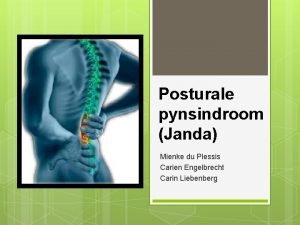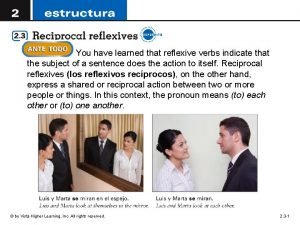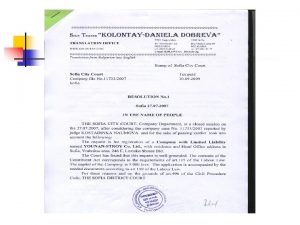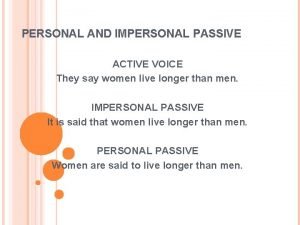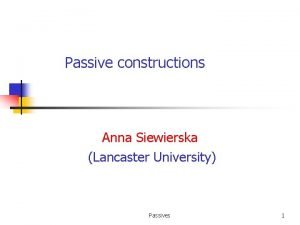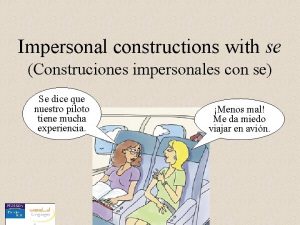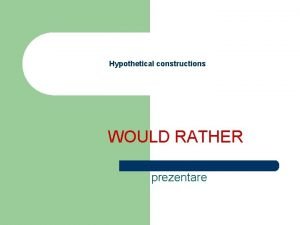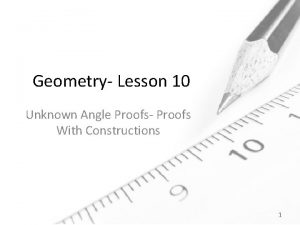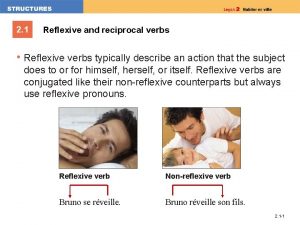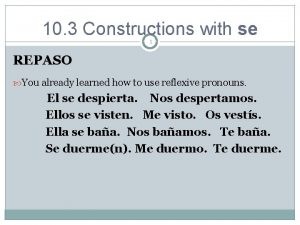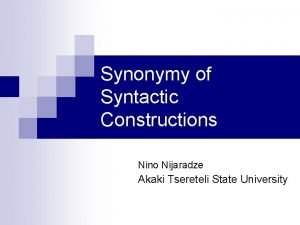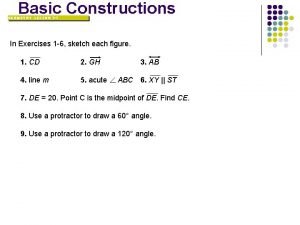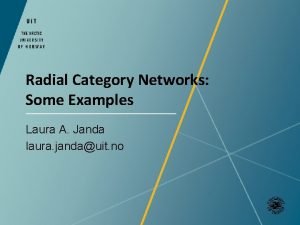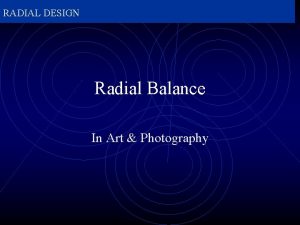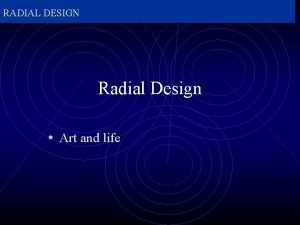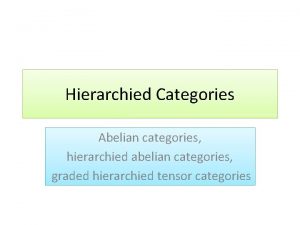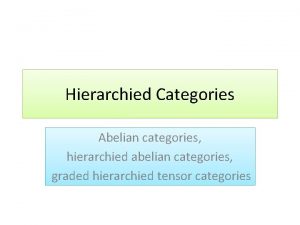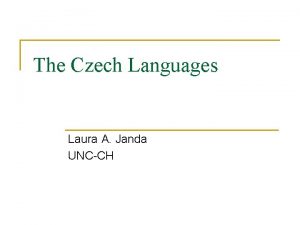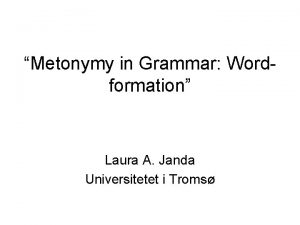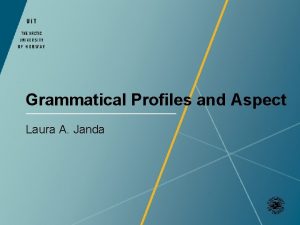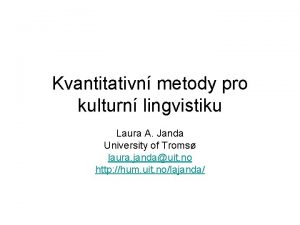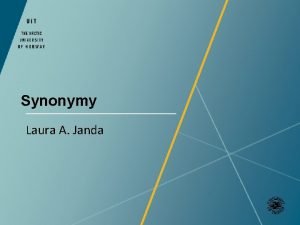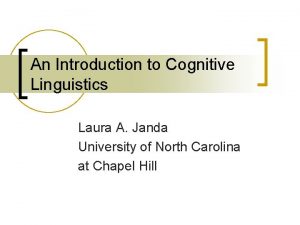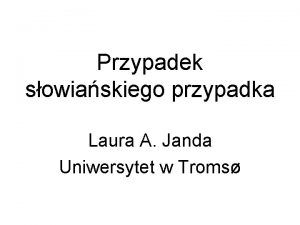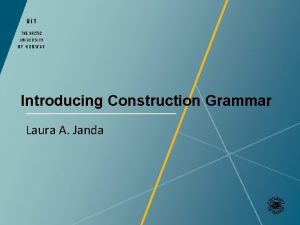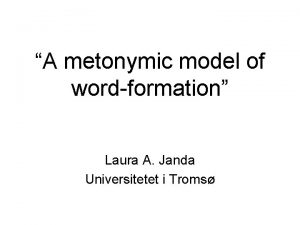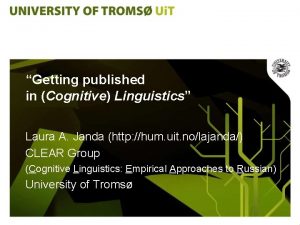Radial categories of constructions Laura A Janda University























- Slides: 23

“Radial categories of constructions” Laura A. Janda University of Tromsø (laura. janda@hum. uit. no; http: //hum. uit. no/lajanda) University of North Carolina (janda@unc. edu; http: //www. unc. edu/~lajanda)

The purpose of this talk is to illustrate: • Construction grammar for a language with case marking (Russian) • How constructions are related to each other within a language • How impersonal constructions are integrated into the network of constructions Should I pursue this further, write an article about the radial category of constructions in a case language?

Overview 1. Construction grammar 2. Case meaning in Russian 3. Radial category of constructions 4. Three types of impersonal constructions 5. How constructions are related to each other 6. How relationships influence meaning of constructions

1. Construction Grammar • Goldberg 2006: – “All levels of grammatical analysis involve constructions: learned pairings of form with semantic or discourse function” (5) – A construction can imply meaning unspecified by any particular word or morpheme in the construction (8) – “Both generalizations and instances are stored” (55) – “our knowledge of linguistic constructions … forms an integrated and motivated network” (227) • Essentially compatible with Langacker’s Cognitive Grammar and Croft’s (2001) Radical Construction Grammar

What this talk contributes to Construction Grammar • Shows how constructions (and their nearrelatives) can contribute meaning that is not “in the words” • Shows how constructions are related to each other in radial category • Shows how impersonal “idioms” are integrated into system of constructions

2. Case meaning in Russian • Six cases: – Nominative (N) – Accusative (A) – Dative (D) – Instrumental (I) – Genitive (G) – Locative (L) • Relatively free word order • If N is present, the verb (V) agrees with it • If N is presumed to exist but not expressed, it has 3 pl agreement (‘they’) Case meaning provides • If N is absent, V has default (neuter 3 sg, much of the structure for ‘it’) agreement constructions in a case language like Russian

“Bare case” meanings for the four cases we will focus on: • Accusative: – a destination • Dative: PPs can use all six cases (these four, plus Nominative and Locative) Verbs can govern all four of these cases – a receiver, an experiencer, a competitor Often the same verb or – a means, a label one verb and a near-synonym can govern both the Accusative • Genitive: and another case – a source, a goal (Dative, Instrumental, or Genitive) • Instrumental:

3. Radial category of constructions • Prototypical construction is Langacker’s (1991: 286) canonical event • Network contains only salient active indicative non-copular constructions • Blends of these constructions are often possible • Lines mark transitions, which are minimal syntactic differences (addition, removal or change in syntactic components) • Not all transitions between constructions are marked • Impersonal constructions are possible in all parts of the network; strongest impersonals are marked with dotted boxes

V+I Russian active indicative constructions A syntactic combination may represent 1 or more constructions N+V+A+I N+V+I V+A N+V+A N+V+G N+V+PP See examples on handout D+V+A N+V+D N+V+A+D D+V

4. Three types of impersonal constructions Strong Impersonals – 3 sg default agr • Dative modal constructions • Raw force constructions Mild Impersonals – 3 pl agr for elided ‘they’ 3. All personal constructions can be converted to mild impersonals

Strong Impersonal constructions V+I Verbs are 3 sg neuter (default) N+V+A+I N+V+I V+A N+V+A N+V+G Raw force impersonals D+V+A N+V+PP N+V+A+D D+V N+V+D N+V Dative modal constructions

“Mild” impersonal constructions N assumed but not expressed V+I Verbs are 3 pl (N)+V+A+I (N)+V+I V+A (N) +V+A (N)+V+G (N)+V+PP See examples on handout D+V+A (N)+V+A+D D+V (N)+V+D (N)+V (N) = ‘they’ or ‘people’

5. How constructions are related to each other 1. Minimal syntactic differences in adjacent constructions 2. Minimal differences in case marking for same argument in adjacent constructions 3. Same or similar verb possible in adjacent constructions All three types of relationships follow the same network of transitions marked by lines in the radial category (diagram insuff) A given transition in the radial category may have one, two or all three types of relationships Transitions closer to the prototype tend to show more relationships

Minimal differences in case marking for same argument in adjacent constructions • • Object: A or PP or G or D or I Temporal Adverbial: A or PP or I (Logical) Subject: N or D Experiencer: A or D

Object: A or PP or G or D or I V+I N+V+A+I N+V+I V+A D+V+A N+V+G N+V+PP N+V+D N+V+A+D D+V

Temporal Adverbial: A or PP or I V+I N+V+A+I N+V+I V+A D+V+A N+V+G N+V+PP N+V+D N+V+A+D D+V

(Logical) Subject: N or D V+I N+V+A+I N+V+I V+A D+V+A N+V+G N+V+PP N+V+D N+V+A+D D+V

Experiencer: A or D V+I N+V+A+I N+V+I V+A D+V+A N+V+G N+V+PP N+V+D N+V+A+D D+V

Same or similar verb possible in adjacent constructions Involves all of the minimal differences in case marking, plus the following • • • N+V+A – N+V+A+D – N+V+D N+V+PP – N+V+A – V+A+I • • • N+V+A+I – V+A+I N+V+A – N+V+A+I N+V+I – V+I N+V+A – D+V+A N+V – N+V+I

Same or similar verb in adjacent constructions V+I N+V+A+I N+V+I V+A D+V+A N+V+G N+V+PP N+V+D N+V+A+D D+V

6. How relationships influence meaning of constructions What’s the difference between: Devušku ubilo [Girl-A killed] ‘A/the girl was killed’ Devušku ubili [Girl-A killed] ‘A/the girl was killed’ Why can’t you say: *Devušku ubilo soldatami [Girl-A killed soldiers-I] *‘A/the girl was killed by the soldiers’

V+A+I is surrounded by constructions in which I is an instrument; has no relationship to constructions where I is an agent V+I N+Vpass+I N+V+A+I N+V+I V+A D+V+A (N)+V+A N+V+G N+V+PP N+V+D N+V+A+D D+V

So what do you think? Should I pursue this? V+I N+V+A+I N+V+I V+A D+V+A N+V+G N+V+PP N+V+D N+V+A+D D+V
 Edy suwarno
Edy suwarno Janda
Janda Sekolah sabat powerpoint
Sekolah sabat powerpoint Formulir taspen
Formulir taspen Anti radial vs radial ultrasound
Anti radial vs radial ultrasound Indica el reflexivo reciproco adecuado
Indica el reflexivo reciproco adecuado Younan constructions
Younan constructions Impersonal passive voice examples
Impersonal passive voice examples Passives
Passives Se impersonal ejemplos
Se impersonal ejemplos Rather construction
Rather construction Lesson 10 unknown angle proofs-proofs with constructions
Lesson 10 unknown angle proofs-proofs with constructions Reciprocal reflexives spanish
Reciprocal reflexives spanish Constructions with se
Constructions with se Nino constructions
Nino constructions S.bleyer
S.bleyer Chrisos civil constructions
Chrisos civil constructions 1-6 basic constructions answers
1-6 basic constructions answers Square edge constructions
Square edge constructions S'amuser negative
S'amuser negative Impersonal passive constructions
Impersonal passive constructions Lis et observe les constructions en gras
Lis et observe les constructions en gras What tools did the greeks use in geometric constructions
What tools did the greeks use in geometric constructions Sru projects hyderabad
Sru projects hyderabad

